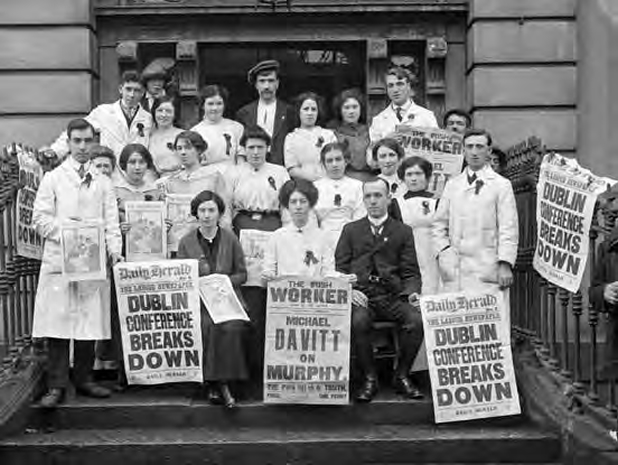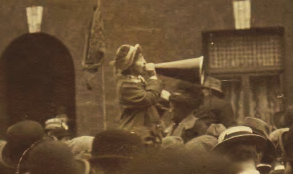
Social historian IDA MILNE discusses the changing view of the role of women in the history of the 1913 Lockout
What women’s voices do we hear from the Lockout narrative? Perhaps the best known, in 2013 terms, would be that of Rosie Hackett, the meek-looking and tiny Jacob’s biscuit factory worker, trade unionist and protester.
For long an unsung hero of the Dublin Lockout and the 1916 Rising, her place in history has now been assured by the successful campaign to name a Dublin bridge after her, even though some claim her actual involvement in the Lockout was relatively minor.
Long after her death in the 1970s, Rosie’s campaign was helped by the fact that she is a female, working class hero at a time when labour and gender history is in an unusually popular phase, just as her achievements were not perhaps recognised in the past as they should have been because of her class and gender.
Constance Markievicz could be viewed as the counter to Rosie Hackett.
Born into a west of Ireland Anglo-Irish family, the Gore-Booths, Markievicz for many years was the female icon of 1913 and 1916 – a gun-toting hero who became the first woman elected to the British House of Commons, and was also elected to the Dáil serving as the first Minister for Labour.
Unlike Hackett, Markievicz’s role was always emphasised; she was noteworthy because she had been a young lady of high society, making her debut to Queen Victoria in 1887. She was also part of the dominant narrative of 20th century Irish history – nationalist republicanism.
Perhaps the shine on Markievicz’s star as an icon for Irish womenhood and nationalism is fading as we witness a welcome upsurge in the popularity of labour history; perhaps, too, in this upsurge, her class plays against her.

IMAGE ABOVE: An unidentified woman addresses a crowd of strikers during the 1913 Lockout (credit – Terry Fagan, North Inner City Folklore Project). TOP IMAGE: Members of the Irish Women Workers Union (IWWU) at its Dublin headquarters (credit – National Library)
Some of their stories are being resurrected by the 1913 Alternative Visions oral history project researchers, who are collecting oral accounts of the legacy of the Lockout.
Suffragist and trade unionist Louie Bennett was among those who worked on the relief effort at Liberty Hall during the 1913 strike and Lockout in Dublin. She also called for financial support for strikers’ families, through the Irish Citizen.
Bennett, an inspirational character, founded the Irish Women’s Reform League, which investigated, among other issues, women’s working conditions.
Or the republican trade union activist and actress Helena Molony, who was an official of the IWWU for more than 20 years.
During the Lockout, Molony employed her acting skills to disguise James Larkin as a clergyman, bringing him into the Imperial Hotel, while posing as his niece, for Larkin’s famous balcony address to the crowd in Sackville Street, which resulted in the ‘Bloody Sunday’ police baton charge. She also addressed meetings about the Lockout.
Then there’s Delia Larkin, the sister of Big Jim Larkin, herself a towering figure in the trade union movement, another general secretary of the Irish Women Workers’ Union.
Larkin, who launched the IWWU, not only ran the food operation in Liberty Hall, but also was involved in trying to foster strikers’ children to families in Liverpool.
As my colleague and lead on the 1913 Alternative Visions Oral History Project, Dr Mary Muldowney, pointed out during a talk on women and 1913 at a commemoration in Dún Laoghaire, Delia’s place in Irish history is assured, neatly behind her brother, James – as his tombstone in Glasnevin symbolises.
On the front of the tombstone James Larkin’s attributes are mentioned, while the side bears the legend “and his sister Delia”.
It says a lot about how society values a woman who was a wonderful organiser in her own right, and the leading woman trade unionist of her day.
Our schools history curriculums have paid scant attention to these women, even Markievicz.
One of the more valuable lessons we might learn from the current commemoration is that unless we make a conscious effort to document the achievements of our female trade unionists, past and present, we are losing opportunities to point to women activists as role models.
IDA MILNE is a social historian (specialising in medical history) who uses oral testimony to explore her research interests. With Dr. Mary Muldowney, she organised the 1913 Lockout Alternative Visions oral history project, training trade unionists and community activists to collect oral histories in their workplace and communities.
PLEASE NOTE: This article was originally published in the Liberty newspaper, the monthly SIPTU newspaper which is distributed to over 50,000 union members, and we have republished it with their very kind permission.
This particular article is taken from the October 2013 special issue, which marks the centenary of the 1913 Lockout.
PDF: Click here to view the entire 1913 Lockout centenary issue.









